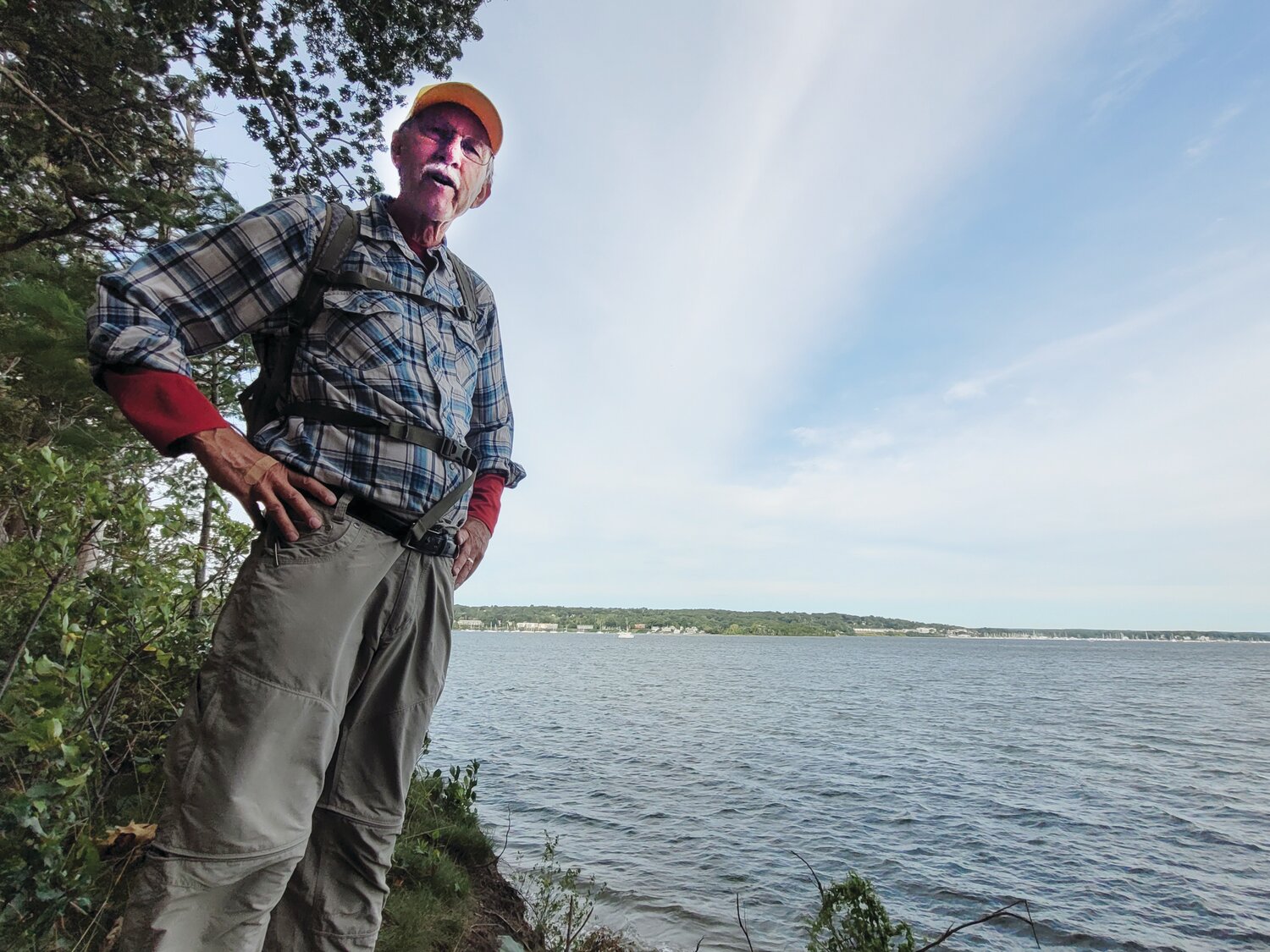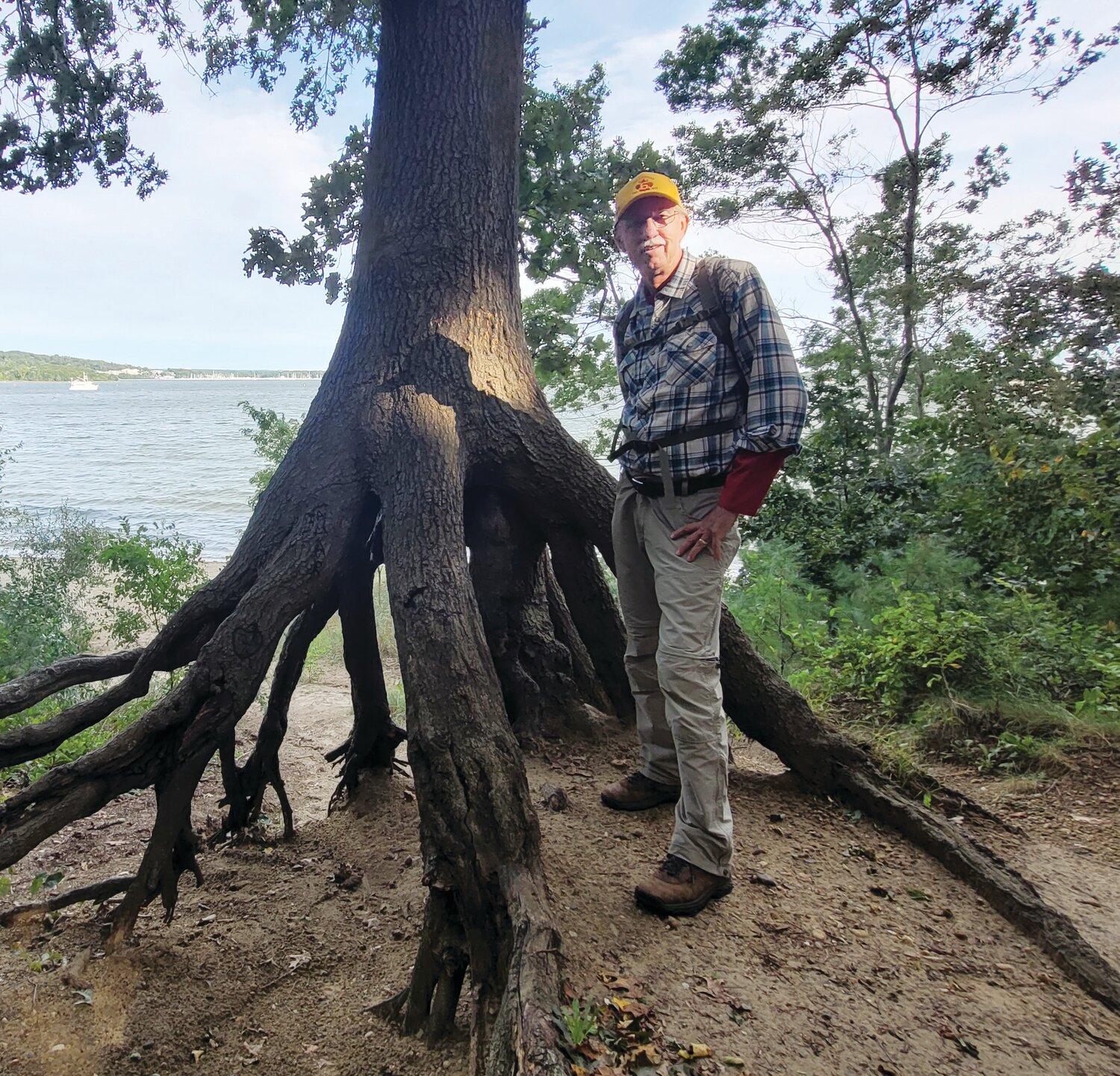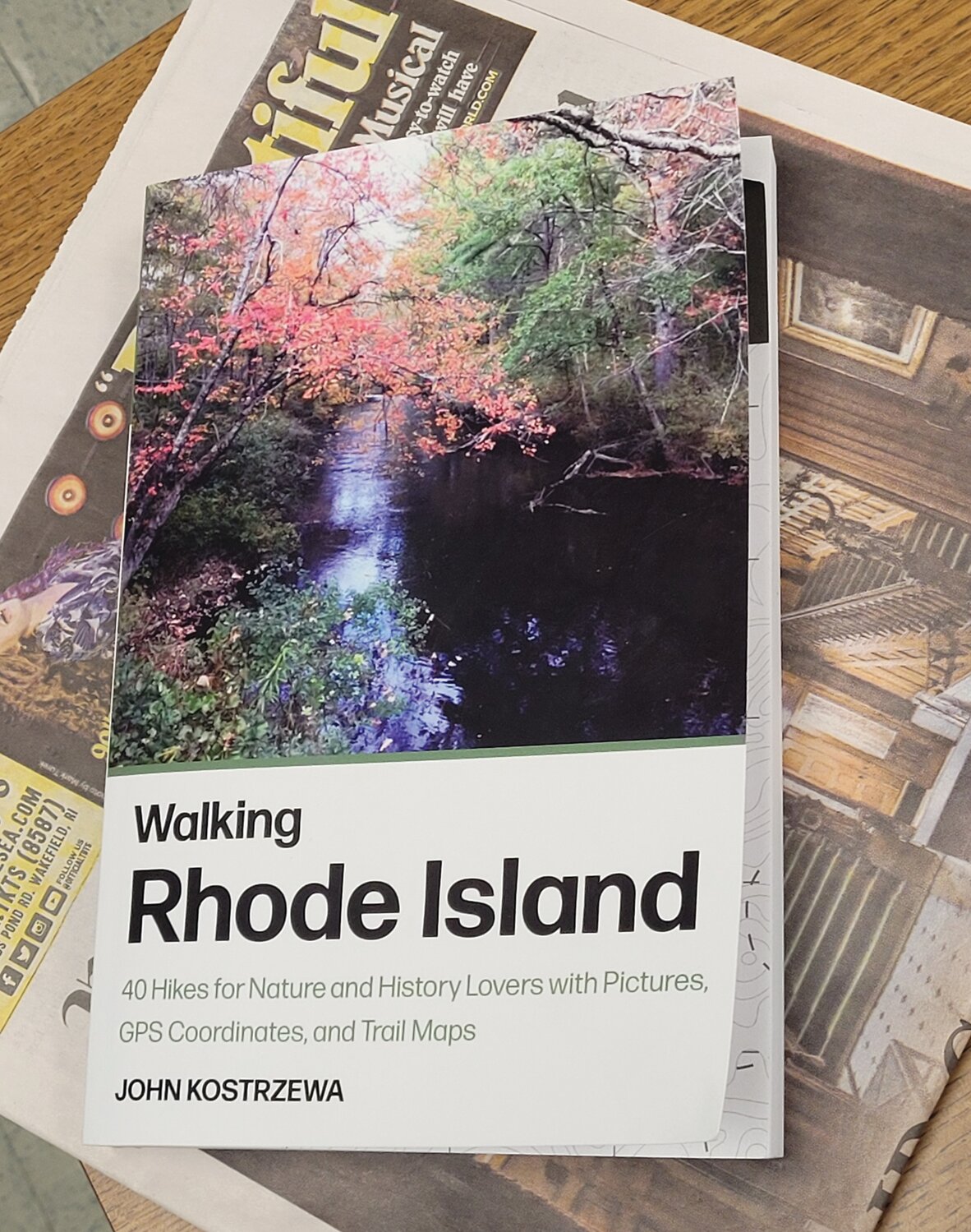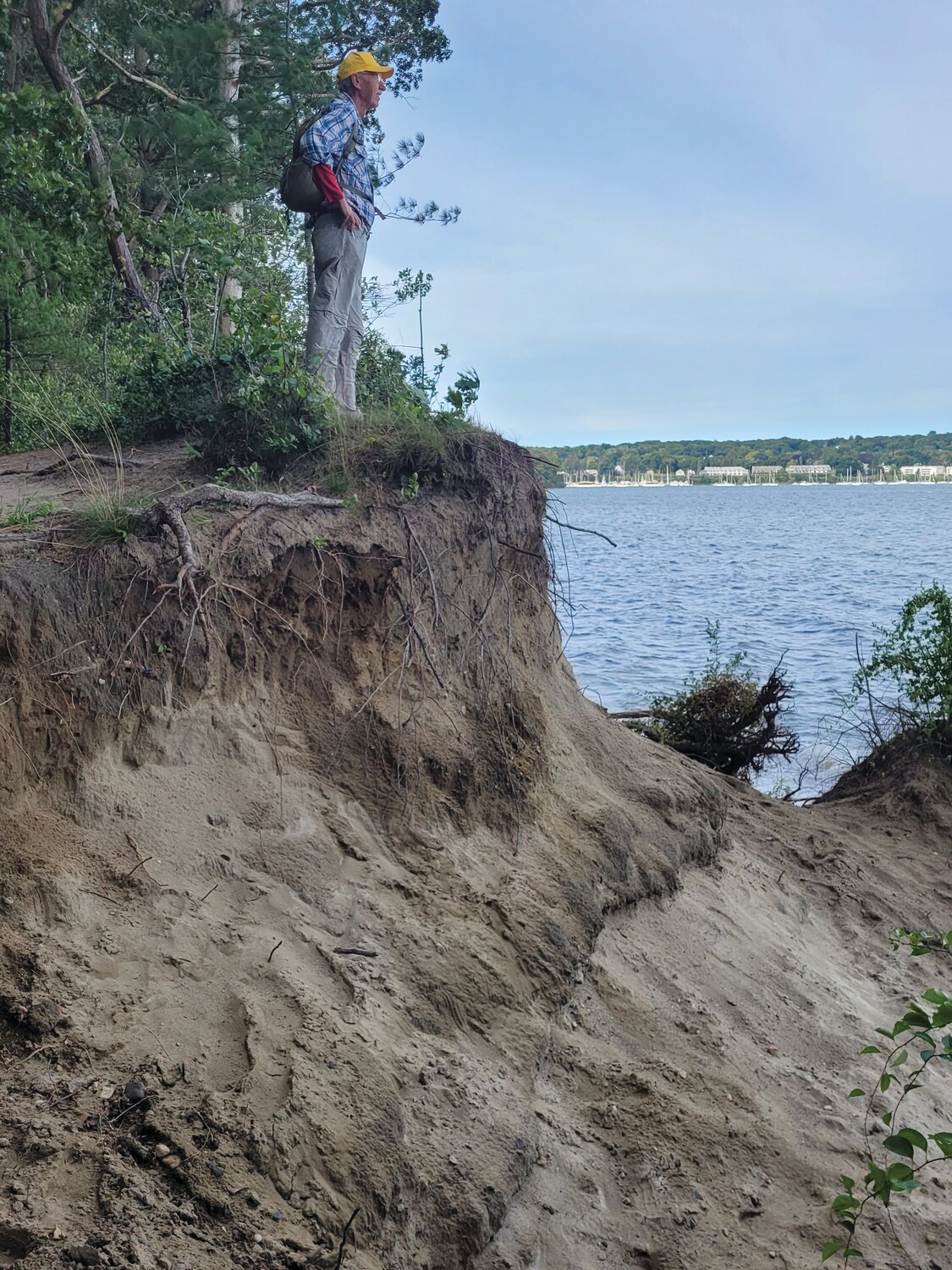Telling retirement to ‘take a hike’
John Kostrzewa publishes column compilation ‘Walking Rhode Island’
Reporter’s Note: Unable to write the first line of this feature, I took the story subject’s advice, and took a walk. “Walking’s a great way to clear your mind,” suggested retired journalist and author John Kostrzewa. [10 minutes later] So, here it goes …
Picking up litter like breadcrumbs, John Kostrzewa embarked on a familiar trek, fully confident he’d discover something new once again.
Just a few feet onto the trail at Goddard State Park, the author leaned down to pick up a piece of trash. He tucked the paper scrap into his pocket and continued up a small hill.
“These trails have been used hard,” he said while taking long steps and scanning his surroundings, his ball cap bill swinging left to the shoreline, and right, into the forest.
The longtime newspaper columnist and retired editor scowled at a dog turd encapsulated in a tiny colorful poop bag — smelly litter preserved for future walkers. He easily fought the temptation to tuck the soggy biohazard into his pocket. (He has no problem with dog walkers. But if they leaned over to trap the turds in plastic, then why leave the bag behind? The dog poop bag problem’s becoming epidemic on the Ocean State’s well-tread woodland trails.)
Despite the occasional tiny twisted landmine, Kostrzewa has a passion for sharing Rhode Island’s best hiking spots. Above all else, he loves a good walk — and he loves making discoveries along the way.
Step-by-Step
In August, Kostrzewa self-published a compilation of hiking columns he wrote for his former full-time employer, The Providence Journal, in a book called “Walking Rhode Island: 40 Hikes for Nature and History Lovers with Pictures, GPS Coordinates, and Trail Maps.”
“Walking Rhode Island is your guide to 40 of the most scenic, natural, and historic trails in the state,” declares the book’s Amazon listing. “Casual walkers, families, and experienced hikers can pick from easy, moderate, and challenging hikes. Each trail has descriptions of the geological features, wildlife, vegetation, and historic landmarks, directions to the trailheads, and trail tips.”
Last week, Kostrzewa had lunch with the Warwick Rotary Club. After the meal, he gave attendees a taste of his newly published hiking companion.
He shared photographs from several key walks, including a climb across the rocky steps of Hopkinton’s “cathedral,” a high-walled cleft that leads to a perch above Long Pond, where director Wes Anderson filmed scenes for the movie “Moonrise Kingdom.”
He and the Amazon listing for his book challenge readers to “spot ospreys soaring high above Great Swamp in South Kingstown” or “explore the remains of a Colonial farm at Parker Woodland in Coventry.”
On Friday, Kostrzewa took a walk, re-enacting Chapter 29, on a breezy late summer morning.
Off the Beaten …
While walking the Goddard path, Kostrzewa acknowledged the seemingly inherent Rhode Islander fear of traveling more than 15 minutes from home.
“I think Rhode Island is really a state of neighborhoods,” he explained. “It’s not so much what town you liven in. It’s, ‘What neighborhood are you from?’”
Despite residing in the nation’s smallest state, Rhode Islanders have a high ratio of walking trails, per capita, compared to other densely populated regions. And the Ocean State’s deep historical roots stretch back, far beyond the land’s first colonial settlers.
Every walk provides a history lesson.
Kostrzewa carefully stepped between tender tree roots that had been further exposed by recent rainfall erosion. He leaned down to pick up a small, black fabric hair-tie; one less morsel of litter on the trail.
The park once belonged to “Robert Goddard, a Civil War officer and Rhode Island politician,” Kostrzewa wrote. “There’s a weathered plaque on a stone pillar at the parks entrance noting that his children donated the land to the state in 1927.”
That’s the quick-hit story. But Kostrzewa digs deeper.
Hidden History
Eventually, the walker reached the Sally Rocks.
From the shore, Kostrzewa pointed out over the row of flattened slippery black stones that stretch into Greenwich Bay and toward Chepiwanoxet Point.
He retold the story he described on Pages 167-171 of his book — the tale of a warring nation’s first airplane manufacturer, founded by Yale physics professor Edson Gallaudet and constructed with the “backing of Rhode Island investors.”
“He built seaplanes over there on Chepiwanoxet Point,” Kostrzewa said from the shoreline, while squinting in the sunshine. He traced the World War I era seaplane factory to the state’s first aviation death — a brave pilot who lost his life in these same choppy waters.
“I learned later that a test pilot, Jack McGee, became the first aircraft casualty in Rhode Island when a pontoon on the Gallaudet seaplane he was flying dipped and struck a swell,” Kostrzewa wrote. “The plane flipped and McGee drowned just off the point where I was standing.”
At the scene, he reflected for a moment, reconciling the history with the site’s natural beauty.
“That’s Rhode Island,” he said while stepping away from the water. “Just get off the beaten path and you get all this great history.”
Kostrzewa has been hiking across Rhode Island for decades and worked at The Providence Journal for 29 years as a reporter, columnist, business editor, and assistant managing editor, according to the author’s book jacket bio. He retired in 2017. After leaving the newspaper business, Kostrzewa continued to hike and compile stories. His “Walking Rhode Island” column launched in 2021 and still appears online and within the paper’s Sunday edition.
The College of the Holy Cross graduate currently resides in Cranston with his wife Carol.
Trail Heads
Admittedly, and proudly, Kostrzewa literally followed in the footsteps of another longtime Providence Journal employee and conservation activist, Ken Weber.
He starts his book with a description of the Ken Weber Conservation Area, a trail that begins where a dead-end road terminates off Route 44 in Smithfield.
Prior to his death in 2007, Weber “cut the trail here that’s named in his honor,” Kostrzewa wrote.
Weber also authored a book — “Walks and Rambles in Rhode Island” — which many avid Ocean State walkers, including Kostrzewa, consider “the bible of hiking in the state.”
The late author and trailblazer’s wife gave Kostrzewa a blurb for his new book.
“Ken loved to walk the trails and take his time to enjoy all that was around him,” wrote Bettie Weber. “Reading ‘Walking Rhode Island,’ and especially the column about the Ken Weber Conservation Area, gave me a great feeling. Thank you.”
There’s salvation in those Ocean State woodlands. Kostrzewa echoes Weber’s thesis: slow down and appreciate it, “instead of always watching the puck.”
You don’t have to be a broken down newsroom wordsmith to walk Rhode Island with Kostrzewa. But it helps.
“Get out and see what you can see in the woods,” Kostrzewa said. “Take your time.”
















